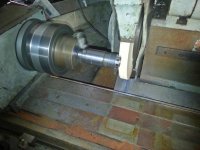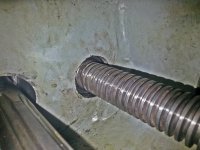RC99
Diamond
- Joined
- Mar 26, 2005
I was watching some videos on youtube of Jafo Jarocin mills like what I have and noticed they have a rapid travel feature. Mine has a rapid button, but all it ever did was engage the feed motor and move the axis in whatever feed speed was selected at the time. In the videos pushing the rapid button made the axis rapid, then went back to normal feed speeds when released.
So removing a cover and peering into the gearbox revealed an electrical wire heading into the innards. I suspected an electromagnetic chuck, and found where the wire exited from the feed box. I also found a blown fuse, bypassing it made the 24V light work and 24V to this mystery wire when the rapid button was pushed.
I would not normally had done anything about it, but on this mill for some reason the table points up to the moon, so I wanted to fix that anyway. And the knee gearbox was full of crud which needed cleaning out. It is of Russian communist era design, so heavy castings, simple enough design but a lots of hours to get things apart as have to pull things off to get other things off to get the gearbox out.
The removed feed gearbox looks like this
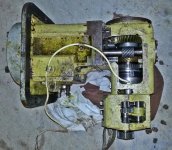
To remove it the z axis screw has to be removed, along with other things due to it's L shape. Upon removal an electromagnetic chuck was revealed. The gearbox splits into two and after much swearing at russian/polish designers of the era the open circuit clutch coil was removed. To get to the clutch a few other things had to be removed that really should not have to be.
The coil was epoxied in so I cooked it in my heat treatment oven until the epoxy decomposed and the coil revealed. The clutch is a Stromag ER5 24V 37W. I was intending to try to make the coil myself, but I have no coil winding machine and a shop in town has done these before so they did the coil for me.
All I had to do was clean up the epoxy a bit as they made it a bit too proud. Testing on 24V reveals it works.
the old coil
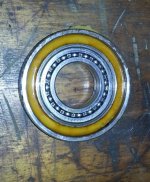
Epoxy cooked out revealing the coil itself

repaired

In the process of putting the gearbox back together.
Which leads me onto finding out why the table points into the air.
With the knee stripped but still on the machine, putting a square onto the knee butting up against the column reveals the problem is not there.
So are there is some minor wear on the knee ways I will scrape them in again.
I have started with one flat way and here is a pic half done.
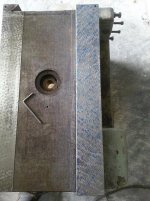
It only took half a dozen passes to get this far and another four and it was done.
Now working on the little guiding ways, then make the other flat way parallel to the finished one. Doing it this way as there is very little to scrape off. it is not worn much at all. Will describe a different way further on.
I have had to grind up a skinny steel straight edge to do the guiding ways. Slideway grinder was interesting to work, there is a 0.0002" bow I could not grind out. The grinding wheel would grind on the ends and just dust the middle which an indicator said was a 0.0002" rise on the ends, but I could not grind it out. Just more things to learn how to do I guess.
So removing a cover and peering into the gearbox revealed an electrical wire heading into the innards. I suspected an electromagnetic chuck, and found where the wire exited from the feed box. I also found a blown fuse, bypassing it made the 24V light work and 24V to this mystery wire when the rapid button was pushed.
I would not normally had done anything about it, but on this mill for some reason the table points up to the moon, so I wanted to fix that anyway. And the knee gearbox was full of crud which needed cleaning out. It is of Russian communist era design, so heavy castings, simple enough design but a lots of hours to get things apart as have to pull things off to get other things off to get the gearbox out.
The removed feed gearbox looks like this

To remove it the z axis screw has to be removed, along with other things due to it's L shape. Upon removal an electromagnetic chuck was revealed. The gearbox splits into two and after much swearing at russian/polish designers of the era the open circuit clutch coil was removed. To get to the clutch a few other things had to be removed that really should not have to be.
The coil was epoxied in so I cooked it in my heat treatment oven until the epoxy decomposed and the coil revealed. The clutch is a Stromag ER5 24V 37W. I was intending to try to make the coil myself, but I have no coil winding machine and a shop in town has done these before so they did the coil for me.
All I had to do was clean up the epoxy a bit as they made it a bit too proud. Testing on 24V reveals it works.
the old coil

Epoxy cooked out revealing the coil itself

repaired

In the process of putting the gearbox back together.
Which leads me onto finding out why the table points into the air.
With the knee stripped but still on the machine, putting a square onto the knee butting up against the column reveals the problem is not there.
So are there is some minor wear on the knee ways I will scrape them in again.
I have started with one flat way and here is a pic half done.

It only took half a dozen passes to get this far and another four and it was done.
Now working on the little guiding ways, then make the other flat way parallel to the finished one. Doing it this way as there is very little to scrape off. it is not worn much at all. Will describe a different way further on.
I have had to grind up a skinny steel straight edge to do the guiding ways. Slideway grinder was interesting to work, there is a 0.0002" bow I could not grind out. The grinding wheel would grind on the ends and just dust the middle which an indicator said was a 0.0002" rise on the ends, but I could not grind it out. Just more things to learn how to do I guess.









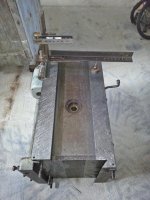

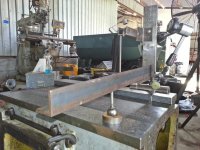



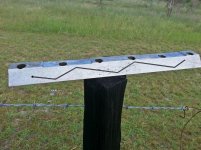


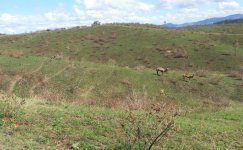


 The steel cap fell out a fair while ago and I was made redundant on the job I had that required me to wear steel caps, so no need to replace my shoes just yet
The steel cap fell out a fair while ago and I was made redundant on the job I had that required me to wear steel caps, so no need to replace my shoes just yet 

